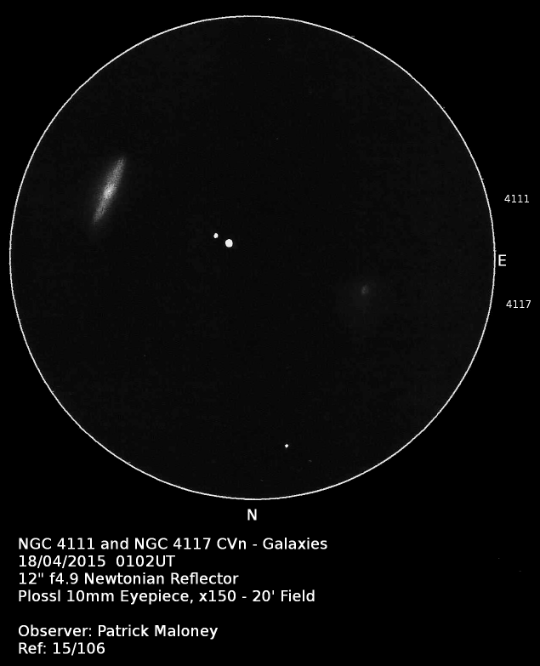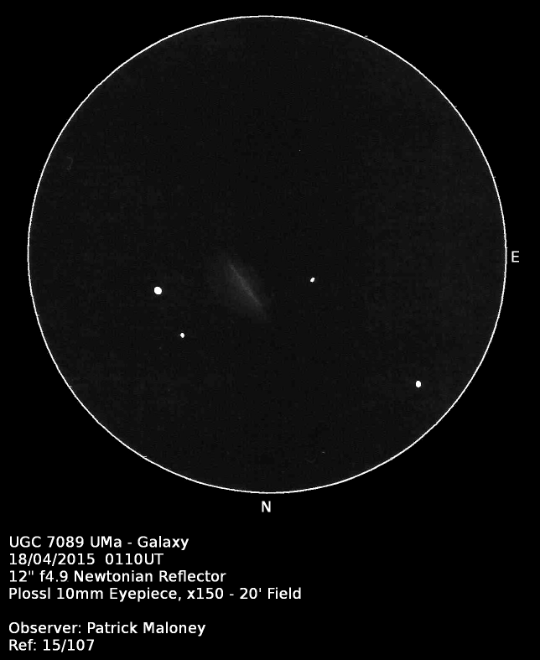These are our observations in Canes Venatici
-
M 63 and NGC 4631 in Canes Venatici
I noticed someone’s picture of Messier 63 in the last magazine that consisted of many 900 second exposures through various filters and thought I’d give it a go.

This image of the Sunflower Galaxy (M 63) was provided by Richard Weatherley. Click on the image for the larger version. I have another one taken two nights ago of the Whale Galaxy (NGC 4631). The Hockey Stick (NGC 4656) is visible in the bottom right too.

This image of the Whale Galaxy (NGC 4631) was provided by Richard Weatherley. Click on the image for the larger version. Both images are a single colour shot of 1000 second exposure. The sky is so much clearer at the moment so tracking programmes perform better. Probably never be as good again.
Image Details
- Telescope: AG14 Orion F 3.8
- Camera: FLI Microline Camera
Richard Weatherley - (20 May 2020).
-
Observations of the NGC 4111 group
Seeing that NGC 4111 is the galaxy of the month for May, I checked my observing records and saw that I had made an observation on 18th April 2015. On that occasion, I was at my home, sub-optimal site and described the weather as still and mild with no interference from dew or Moon. The temperature was hovering around 6C. The instrument used was, as usual, a 12" Newtonian reflector with a 10mm Plossl eyepiece.

I saw two objects in the 20' (x150) field of view, NGC 4111 and NGC 4117. Most of the other galaxies nearby are beyond my skies here, however I did manage to see UGC 7089, although as this was outside the 20' field, a separate observation was made. The descriptions I made of the galaxies are as follows:

- NGC 4111 : Very bright, small and very, very elongated. There is a much brighter central area with a stellar nucleus. Averted vision increases the apparent length of the galaxy.
- NGC 4117 : Very faint, small and round. Visible to averted vision only (AV/2).
- UGC 7089 : Very pale and difficult. Better with averted vision (AV/1). Long and highly elongated, averted vision hints at possible brightening near the middle.
Hope these are of interest.
Patrick Maloney - (17 May 2016).
-
Observations around NGC 4111
Early May has been a busy time around the east of the country. Our Galaxy of the Month for May 2016 (NGC 4111) has already had two observers it seems: Mike Wood and Andrew Robertson.
Mike Wood's Observations

Observing at NELM 5.4 under claggy skies with a 20" Dobsonian just after midnight on the 5 May 2016.
Initially I had been observing the Abell 1656 Cluster and when I trained the scope onto NGC 4111 its brightness compared to the 1656 cluster galaxies was a real treat. NGC 4111 had a clearly obvious inner core surrounded by a less bright halo with the two arms easily seen. At times these arms could be perceived extending further and wider than indicated by the sketch. NGC 4117 small and oval in shape was easy to pick up with a hint of a core. Its immediate neighbour NGC 4118 had to be located using Averted Vision (AV) but once pinpointed could be seen direct.
NGC 4109 was seen as a poorly defined small patch of fuzz. As a bonus the double HJ 2596 lies near to NGC 4111.
Using the 13mm ethos UGC 7089 was spotted as a large oval fuzzy patch and to my surprise a hint of PGC 38276 was observed; confirmed in the 8mm ethos. I also tried for UGC 7094 and using AV something was detected now and again.
A delightful time spent observing a classic edge on galaxy.
Andrew Robertson's Observations
Observing on Monday night (2 May 2016) with the 600mm Dobsonian at home in South Norfolk. My skies on Monday night were excellent, best I’ve had from home reached 21.50 SQM.
NGC 4111 group observed and 8 galaxies seen using a mix of 13mm and 8mm Ethos (x208 & x340) at 00:50 hours and 21.45 SQM and NELM easy 5.8.
- NGC 4114
- NGC 4117
- NGC 4111
- MAC 1206+4259 (4.7 ethos at x575 used for this)
- NGC 4109
- UGC 7094 (AV1 - see below)
- UGC 7089 (large elongated and easy)
- and another the other side of a bright star from UGC 7089
I saw a faint galaxy to the left of NGC 4109 which I assumed to be MAC 1206+4259 but it may have been MCG +7-25-25 which Mike saw.
Averted Vision
For those that don't know, AV1 means averted vision to acquire but once acquired direct vision. This is a commonly used scale developed by Ron Morales.
-
Some observations of the NGC 4449 galaxy
David Reynolds' observation
The SQM was now 20.82, about the same as two hours earlier. This sketch was made of the view through a 600mm f4.5 Dobsonian with an Ethos 8mm eye piece.

NGC 4449 gx CVn (Webb Object of the Season). I looked at this last night and I was keen to revisit it tonight on a better night. It is a mass of swirling nebulosity and bright knots. I counted five knots, Overall it gives me the impression of a rectangle, with circular swirls at the S end and two bright projections going N. It is quite complex to sketch, and I was very interested in seeing Dale's sketch of it, which shows much more than we can see. The burnt out ccd image in the NSOG doesn't do it justice. A lovely object allowing the stellar artists to show their skills, Dale.
David Reynolds (18 February 2015).
Dale Holt's observation
Here we have some sketches from last night, including Wolfgang's very interesting Webb Society seasonal object the irregular galaxy NGC4449.

This sketch was made using the 505mm mirror and Watec 120n+ video camera.
Dale Holt - (22 February 2015).
-
Supernova 2014bc in M106
 Image Courtesy of David Davies, Cambridge, UK.
For more images from David please visit his
Flickr Photostream.
Image Courtesy of David Davies, Cambridge, UK.
For more images from David please visit his
Flickr Photostream.
David's Observation Notes.
Hello everyone,
Here is my processed stack of 11 x 7 minutes of luminance images showing supernova sn2014bc in M106 captured on 18 May.
This is an interesting processing challenge. If you stretch the image in the usual manner to bring out the details of the galaxy, then the core tends to burn out and the supernova becomes impossible to see. In this image I have processed the image twice: once to reveal the details of the galaxy, in the usual way, and then a second time to just reveal the galaxy core. I then merged these two images together.
Update
I managed to get out on Saturday 25 May and captured some RGB data on M106. I have combined this with the luminance data captured on 18 May to produce the attached LRGB image. Regards David'
Image details
- Exposure Details
- 11 x7 minutes of luminance, binned 1 x 1; 8 x 5 minutes of each RGB binned 2 x 2
- Telescope
- 254 mm newtonian plus Paracorr coma corrector at F/4.5
- Camera
- QSI 583 wsg plus Lodestar off-axis guider
- Mount
- NEQ6 controlled via EQMOD